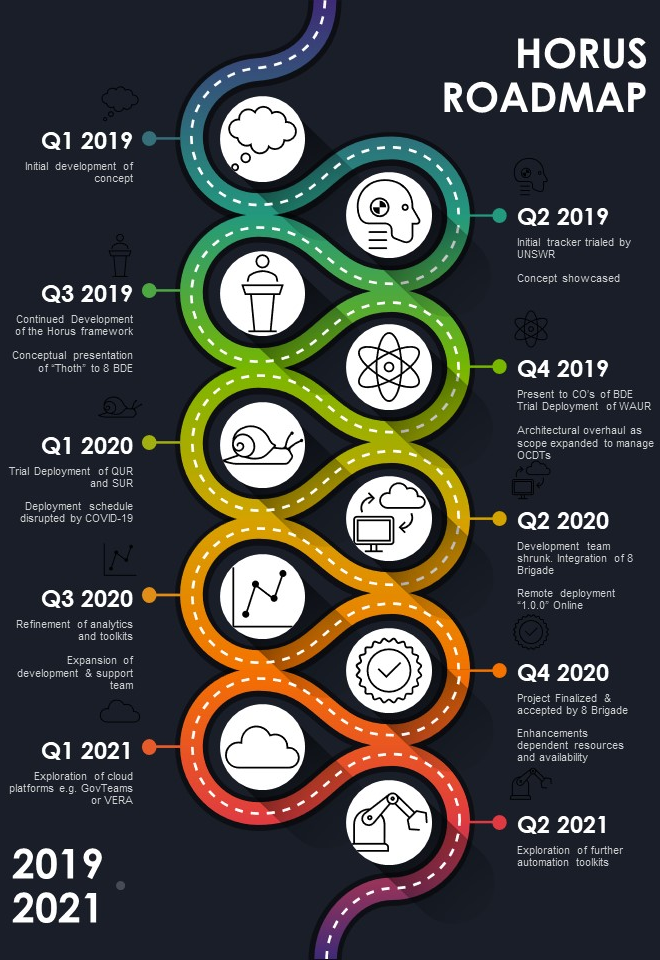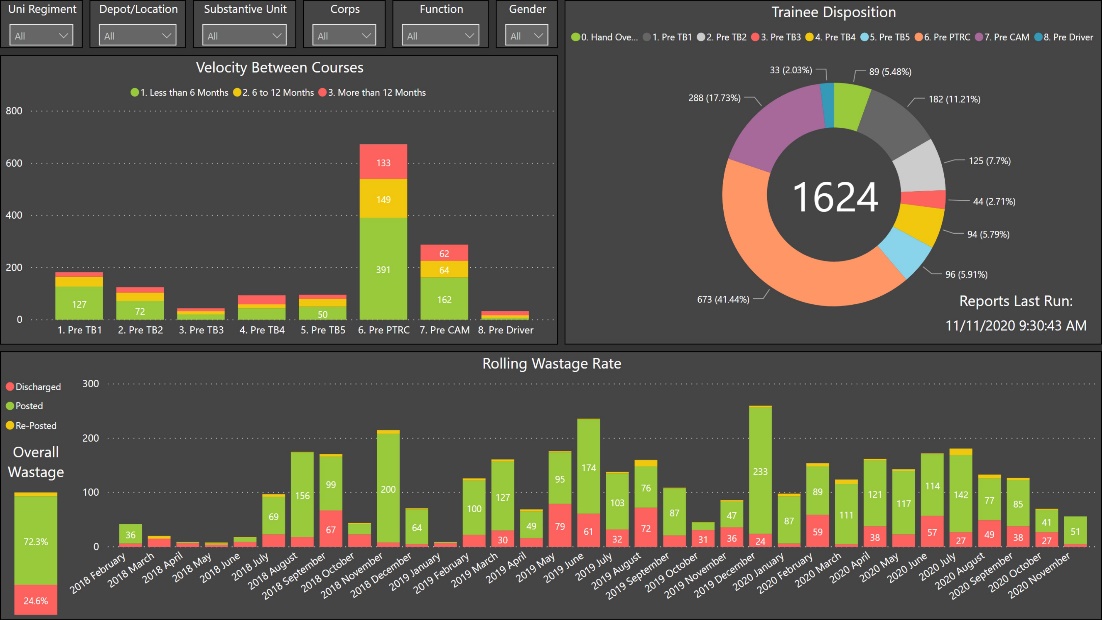Executive Summary
Over the past 21 months, the University of New South Wales Regiment (UNSWR) devised and developed Project Horus. Horus provides dashboards and toolkits for the management of trainees within the Army Reserve. It was scaled to the other University Regiments (URs) and vertically integrated into a Brigade dashboard, providing data insights for staff of all levels. It has saved thousands of hours across the Brigade and facilitated the growth of a data driven culture. Investigations have begun on how to integrate Horus into the Army Data Hub, to improve the reliability of the project and to serve as an example of what Army can do to become Future Ready.
Background
In 2018, Army transformed 8th Brigade into a training establishment that contained all the URs across the country. Each UR was responsible for the training and administration of newly enlisted soldiers and officers until the designated release point. The Regional Induction Company (RIC) was raised in each UR to manage these troops until they were handed over to the Battalion.
UNSWR had 838 trainees posted to the unit during 2018. They had assigned 31 staff to the RIC, of which 26 were reservists. The staff/trainee ratio was 1:27. Trainee management was complicated by geography, spanning from Lismore to Mildura and supporting trainees from most trades within the Army Reserve.
Like most units in Army, UNSWR was using multiple Excel trackers. Data was laboriously gathered by hand from a variety of sources including PMKeyS, Defence Force Recruiting and local communication with soldiers. The multiple systems had the inherent risks of duplication and human error. This made managing trainees, planning, and providing reliable metrics to decision makers time consuming and difficult.
A problem with many moving parts
There was a need for an integrated, secure system that could meet the demands of all of users, regardless of rank or function. The system would need to be simple, easy to use, flexible, trustworthy, and stable. The system needed to facilitate concurrent users during busy periods such as Tuesday nights.
For any system to meet the needs of decision makers, it must be built bottom up; empowering, and engaging operators and users at every level. User engagement increases when there is a sense of autonomy, reduced complexity, and critically timesaving for staff. Soldiers value being effective and efficient in discharging their duties.
UNSWR needed a business system that could hold all relevant data and become a single source of truth for planning and decision making. While PMKeyS is our global reference point for data, it is not designed to handle the dynamics of day to day operations.
UNSWR needed a business system that would minimise data error and maximise integrity, while managing fields of data beyond the scope of PMKeyS. For example, PMKeyS is unable to manage information such as parade location for a high turnover unit where all members are posted into a single pool position. The system also had to be resilient to human error whilst enabling high user accessibility to the data needed.
There is a story about the elephant and the rope.

A tourist (pre COVID-19) was passing a herd of elephants. He stopped, curious that these huge creatures were being held by only a small rope tied to their front leg. No chains, no cages. It was obvious that the elephants could, at any time, break away from their bonds but for some reason, did not.
He saw a trainer nearby and asked why these animals just stood there and made no attempt to get away. ‘Well,’ the trainer said, ‘when they are very young and much smaller, we use the same size rope to tie them. At that age, it is enough to hold them. As they grow up, they are conditioned to believe they cannot break away. They believe the rope can still hold them, so they never try to break free.’
This project started because the rope needed to be tested. ‘This is the way we’ve always done it,’ was the rope. There had to be a better way of doing business so that we could free resources to focus on our purpose – train and develop soldiers to be Future Ready.
It put me in a very difficult situation: stay in my lane, or challenge convention and think outside the box. Captain Ryan Scott of the US Army wrote an article about Wilful Disobedience, his writing resonated with me probably more than it should have. I occupied the precarious position of being a recently trade-transferred soldier, who had failed officer training.
Project Horus
At the end of Q1 2019, I started work on what would become Project Horus. Within 3 months Horus evolved from generating standard reports and data calculations into an integrated solution that enabled us to decommission five Microsoft Excel trackers. Horus was able to reliably generate unit performance metrics and began developing trusted dashboards for the chain of command. The system was scaled to the point where staff could concurrently enter data via SharePoint lists. Horus also generated reports and returns for Brigade, saving hours per week for UNSWR.
Within six months we had automation tools for travel forms. Time taken was reduced from 15 minutes per trainee to a couple of minutes. Bulk lists of trainees who needed to be posted to units, could be generated in seconds. Previously this took hours. Weekly reports and returns that took hours to generate were reduced to minutes.
Horus gathered interest from Brigade and the other URs. Everything was developing well; some would even call it Gucci. Unfortunately, there were issues.
The elephant in the room
There were three emerging concerns. The first was the use of Excel, which enabled us to rapidly develop and test ideas for UNSWR. Unfortunately, it is less than ideal for scaling a solution across multiple units.
Secondly, there was a proliferation of requests and demands from other URs such as: ‘Can it manage Officer Cadets?’, ‘Can we have our own custom columns?’, ‘Could Brigade have a dashboard?’.
The third problem was the single point of failure and the need for redundancy. Staff had been trained how to conduct basic maintenance but ongoing report running was required. The system needed to be optimised and resistant to failure.
Where we are now: Horus 2020

There are five components to Horus.
1. The Data Core (DC)
2. The Controller
3. SharePoint Lists (Ground Truth)
4. The Decision Support Tool (DST)
5. The Excel and Power BI Brigade Dashboards
The DC is a group of excel sheets that is managed by the Controller. The DC is our single point of information. It is used by all the units as the core for their administration and reporting.
The Controller was built to ingest reports from numerous sources, distribute data to all the URs and provide a deployment framework for future versions. 8th Brigade Headquarter staff have been trained to operate the Controller. They run the reports that drive not only the UR tools but also the Brigade Dashboard, providing necessary redundancy.
The SharePoint Lists, which operate at a unit level, provide the capability to capture ground truth data whilst maintaining the integrity of the single source of truth - PMKeyS. It provides the ability to distribute trainees to different platoons, track the movements of trainees on course and manage the administration of posting or discharging trainees out of the unit.
The DST provides near real-time insights on administrative issues and data integrity that all authorised RIC staff can access within seconds. The DST is also used to identify soldiers already enrolled on a course, according to PMKeyS, and those soldiers who need to be nominated. The DST contains a series of individual and bulk management tools to facilitate administration and reporting; including the ability to pre-fill travel forms, discharge paperwork and generate bulk posting lists of trainees.
The Excel and Power BI Brigade Dashboards provide a dashboard to allow for Brigade level insights. The reports are derived from sourcing data managed by the URs DST’s. The dashboards facilitate data insights such as the number of positions required for trainees and even an interactive schedule of courses to improve course fill rates, reducing under-enrolment.

This dashboard can even be leveraged to identify individual soldiers who should be nominated for a course across the Brigade. This not only improves fill rates on courses but enhances morale as soldiers do not feel forgotten.
The dashboard provides Receiving Units and Formations with an accurate pipeline of soldiers who are due to come to their command, saving time and helping Receiving Units become Future Ready.
Horus 2021 and beyond
Horus has been a great success in improving the efficiency and effectiveness of the administration and decision making of URs within 8th Brigade. The enhancement of reporting through dashboards is already in scope for 2021. There is so much more that lessons learnt from Horus could do for the whole of Army and even other Services. While the specifics of roles, capabilities and reporting lines will vary, the concepts and constructs are similar. What has been developed can and should be expanded.
Three functions illustrate the value of taking Horus further.
- Scalability, Reliability, Machine Learning and Artificial Intelligence - Army Data Hub
- Bulk Messaging and Data Gathering
- Automation Data Driven Decision Making
Scalability, reliability, machine learning and artificial intelligence – Army Data Hub
Horus, or its inevitable successor, provides a platform for managing personnel capabilities from the most granular service personnel level, to unit, division and ultimately, whole of Army. This may seem overly ambitious, but if the proven model of ground up, staged development is adopted, it is both practical and possible.
It is one thing for strategic and forces planning to identify the needs and requirements for forces capabilities, it is another to ensure these needs are put in place. The manual gap analysis process is complex, as is the process of recruiting and training to fill the gap. The future demands that this should be done in real time and over time, in a dynamic, ever-changing world.
The underpinning constructs that enable Horus can be scaled further by integrating with the Army Data Hub. The Army Data Hub could serve as a scalable and reliable foundation to support the internal development of the tools and dashboards we need to be Future Ready. A single source of data will improve the reliability and repeatability of data insights.
A well-constructed data model is the foundation for developing Machine Learning and Artificial Intelligence. Being able to leverage these technological advances has a broad range of applications from administration to complex decision making. Owning this capability in-house will enable a more contextual understanding of the capability it can provide Army to be Future Ready.
Bulk messaging and data gathering
Mass messaging in a secure (but not high security) way allows for rapid distribution of orders and tasks, including the responses, in a sustainable and scalable manner. This was exemplified this year in use of the data from Horus to identify and communicate with soldiers. We were able to identify trainees who needed to conduct COVID-19 Awareness and General Duties Training and enable them to conduct the training from their personal devices using Microsoft Forms in GovTeams.
Soldiers only needed to provide their PMKeyS number, reducing the risk of data capture/leakage. Using Horus provided a solution to the problem that not all trainees have access to the Defence Network, or the ability to set up a defence account to enable ADELE. This provided a timely fix to train over 300 trainees in 72 hours.
Bulk messaging could readily be extended to leverage the data within Horus to message trainees who need to nominate for their next course across the Brigade. This will save time for both soldiers and commanders.
This methodology could be implemented across the whole of Defence to assist in the administration of required information and tracking responses in a timelier and resource efficient manner.
This model as built may not be suitable for certain operations; however, the ideas and principles can be modified appropriately to support those environments.
Automation and data driven decision making
As we become more aware of the information available at our fingertips, we can drive future capabilities such as automation. An example would be the ability to pre-fill forms, reducing administrative burden and data errors. While there may be more efficient solutions for this problem, the short-term extension of Horus philosophy is consistent with current operating systems and the goal of doable, low cost, high impact improvements.
Having a strong data model will improve how we derive our information and make decisions. Horus has proven that the labour-intensive process of collating statistical information can be replaced by a system that is almost fully automated.
The implications for planning and strategic thinking are profound. It is possible that a ‘scenario module’ could be developed to augment assumption based planning, based on intuition and local experience, with augmented data modelling using real world data in a hypothetical model with multiple scenarios.
Conclusion
Project Horus has shown the value and capability of building from the ground up. It has also shown the value in embracing data as part of digital transformation within the Army Reserve. We have been able to save time, amounting to thousands of hours across the Brigade. This time has been reinvested in the training and development of future soldiers of the Army Reserve.
The reports and dashboards allow every leader at every level access to the data they need to make better, more informed decisions. Continuing what we have begun, extending the scope and capability of Horus, is not just possible, it is necessary. This will assist in further simplifying and streamlining processes that make us Future Ready.
All we need to do is test the rope.









